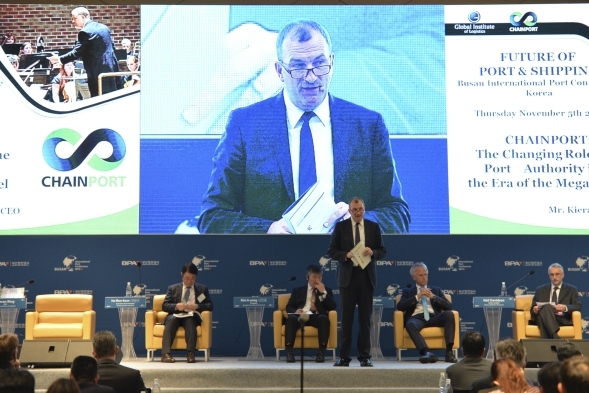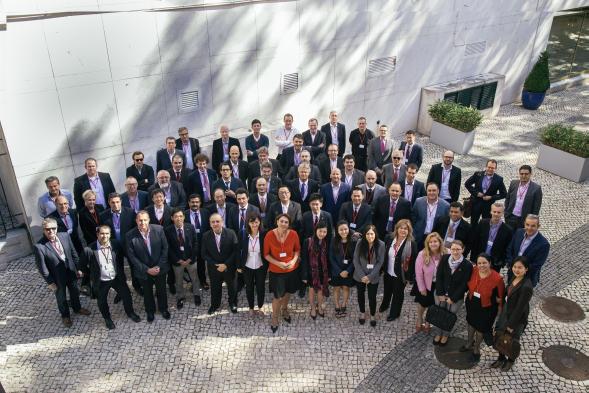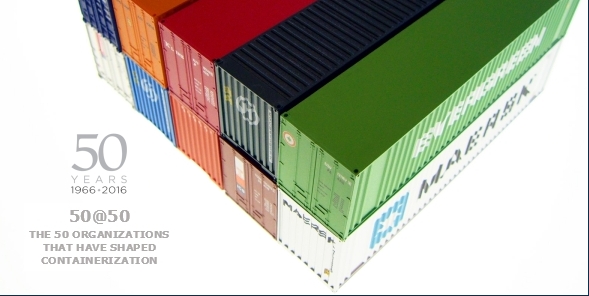2015
2015: INSTITUTE CEO SHARES chainPort VISION AT BIPC 2015
BUSAN KOREA NOVEMBER 2015
2015: INSTITUTE CEO SHARES chainPort VISION AT BIPC 2015
The conference adopted the theme of “Ports Exploring the Unexplored” Its mission was to learn from ports, industries and academia by discussing global trends and issues. The conference discussed 3 key issues affecting the day to day running of ports namely, the advent of Ultra Large Container Vessels, Environmental Regulation and the Panama Canal Expansion.

chainPORT has its genesis in the Institute’s strategic decision 10 years ago to focus on maritime logistics and more particularly the container supply chain as our core research area.This was followed by our decision in 2008 to champion the role of the Port Authority in the supply chain. It is our considered opinion and indeed that of a growing number of thought leaders, that the Port under the direction of the Port Authority can add significant extra value to the global supply chain.
At first glance a port seems to be almost exclusively driven by the vessels which call and the terminal operators who discharge and load them and it’s easy to see why this is the case when most of our attention is constantly drawn to the brands which control these two aspects of port life, attention which is garnered through brand reinforcement through the media either through news or advertising, both of which feed off each other.
Port operation is far more complex and deserves to be better understood especially by cargo owners and port authorities, as much of the inefficiencies in port is due to a myriad of other factors outside the control of both shipping line and terminal operator, much in the same way that the smooth running of an airport depends on much more than planes and ground handling.
“The Evolution of CHAINPORT can be traced back to the establishment of the Global Institute of Logistics in 2003”
Kieran Ring CEO Global Institute of Logistics
To any impartial observer the port as a functional node in the chain presents the most complicated set of obstacles to be dealt with by import and export containers, the simple truth is that the junction box which is the port is made up of a diverse set of companies and organizations each with their own particular agendas, agendas not always necessarily driven by saving time or reducing cost.
CHAINPORT has brought together a group of ports from around the world with shared vision and values to create a singular standardized port system fit for purpose in this era of globalization.
2015: INSTITUTE JOINS WORLD FREIGHT ALLIANCE AGM IN PORTUGAL
LISBON OCTOBER 2015
INSTITUTE ATTENDS WORLD FREIGHT ALLIANCE AGM IN PORTUGAL
The WFA is an alliance of like minded, progressive and proactive freight forwarding logistics companies spread across the globe. Through their worldwide network, WFA offer global and freight solution to Beneficial Cargo Owners. The independent freight forwarding sector is now more vibrant and successful than ever, despite the global economic woes of the past few years. The rise of the independent agent has now been borne out by a whole range of statistics and data that prove that far from shrinking, the independents are growing faster and taking market share from the multinationals.
Latest figures from Drewry show that 41 per cent of all ocean freight is now controlled by 3PLs or forwarders and by the end of the decade analysts are predicting that the market share will rise to 50 per cent – a remarkable switch in business practice by BCO’s over the past two decades. 20 years ago some 75 per cent of all sea freight volumes were booked directly with carriers.
Even more remarkable is that it is independent freight forwarders and not multinational 3PL’s are expected to make up the lion’s share of this total at some 30 %

Make up the World Freight Alliance Network
“This move away from direct booking with carriers by BCO’s is a great opportunity for independent forwarders to gain significant new business and volumes. For the logistics industry this is also a positive development and will help to further integrate the global supply chain.”
Kieran Ring CEO Global Institute of Logistics
This trend by BCO’s to outsource the management of their container traffic to independent freight forwarders, is being driven by increasing frustration with the lack of service, price volatility, schedule unreliability and onerous credit terms experienced in dealing directly with carriers in the sea freight industry.
Cariers due to the huge downward pressure on container rates (largely due to their own misguided strategies) are being forced to increasingly commoditize their product. As a result carriers are increasingly incapable of meeting shipper’s needs through direct relationships as they lack the end to-end service supply chain capabilities, focusing instead almost entirely on cost. Sales and customer service teams have been slashed as the fight to the bottom on rates continues. The advent of super alliances has further eroded the personal interfaces between the shipping lines and the end customers.
2015: INSTITUTE TO NAME THE 50 ORGANIZATIONS THAT HAVE SHAPED CONTAINERIZATION OVER LAST 50 YEARS
Dublin July 2015
INSTITUTE TO NAME THE 50 ORGANIZATIONS THAT HAVE SHAPED CONTAINERIZATION OVER LAST 50 YEARS
2016 marks the 50th anniversary of the Globalization of the Container Transport Process. To mark this significant milestone the Global Institute of Logistics is to create a “Roll of Honor” to honor 50 of the most influential organizations who have shaped the industry over the last 50 years. Each honoree will be accredited by the Institute with its highest accolade the “Award of Excellence” in recognition of their outstanding contribution to the development of the industry. The selection process will be overseen by an accreditation committee comprising members of the Institute’s Hall of Fame. The results will be published in October 2016. A gala lunch will take place in December 2016 to celebrate the Golden anniversary of the Globalization of the Container Transport Process where the formal presentation of accreditations will be made to the organizations included in the Roll of Honor

BACKGROUND
THE GLOBALIZATION OF THE CONTAINER TRANSPORT PROCESS
On the 3rd of May 1966, ten years after containerized shipping started in the US, Sea-Land’s container ship ‘Fairland’ arrived in Rotterdam for the first time, together with three sister ships, all with a capacity of 226 containers, the Fairland operated a weekly container service between North America and Northwest Europe, it was to become the starting point in the globalization of the container transport process. Container ship construction then began to increase over the next couple of years. In 1968, 18 container vessels were built, ten of them with a capacity of 1,000 TEUs (Twenty-Foot Equivalent Unit), which was large for the time. In 1969, 25 ships were built and the size of the largest ship increased to almost 2,000 TEUs. Modern container ships have a capacity of up to 21,000 TEUs for major trade lanes.
Containerization is a testament to the power of process innovation. In the 1950s the world’s ports still did business much as they had for centuries. When ships moored, hordes of longshoremen unloaded “break bulk” cargo crammed into the hold. They then squeezed outbound cargo in as efficiently as possible in a game of maritime Tetris. The process was expensive and slow; most ships spent much more time tied up than plying the seas.
Containerization changed everything. It was the brainchild of Malcom McLean, an American trucking magnate. He reckoned that big savings could be had by packing goods in uniform containers that could easily be moved between lorry and ship. When he tallied the costs from the inaugural journey of his first prototype container ship in 1956, he found that they came in at just $0.16 per tonne to load—compared with $5.83 per tonne for loose cargo on a standard ship. More important than savings on costs were the knock on effects on efficiency, in 1965 dock labour could move only 1.7 tonnes per hour onto a cargo ship; five years later a container crew could load 30 tonnes per hour. Containerisation quickly conquered the world: between 1966 and 1983 the share of countries with container ports rose from about 1% to nearly 90%, coinciding with a takeoff in global trade.
Today, in the 21st century, international supply chains have transformed the global economy by connecting trade, investment, and services. This has been accompanied by the ongoing revolution in information and communication technologies, which has made it possible to manage the complex challenges of coordinating logistics on a global scale. The interconnected global economy depends on reliable, on time delivery of goods and services in order to run smoothly and minimize costly delays. Containerization continues to be the solution to this challenge. Regardless of the occasional shock to the world’s financial system, global trade will continue to expand and the world will continue to get smaller. Containerization’s role is to bring the benefits of global trade to every corner of the planet, moving goods from producers to customers.
In the 50 years since the beginning of globalization of the container transport process in 1966, a host of individuals and organizations have been pioneers in making the complex global systems of transport and logistics work for customers in a simple, reliable way. The aim of the Institute’s 50@50 “Roll of Honor” is to acknowledge 50 of the most influential organizations who have shaped the industry over that period. Our belief is that in in so doing we will bring much deserved attention to the “Humble Hero” of world trade the simple container.
PROCESS
CREATING THE 50 @ 50 ROLL OF HONOR
The Institute has been at the heart of the global container supply chain for the last 20 years and has in that time played a key role in bringing stakeholders together from all aspect of the process. As a result we have an extensive insight into the workings of the industry and most importantly the people and organizations who are leading the way.
This “Hands On” understanding combined with our extensive annual secondary research places the Institute in a unique position to create a “long list” of candidate companies for consideration by the accreditation committee. On further evaluation, the long list will become a short list of 100 companies from which the “final list” of 50 will be chosen.
All shortlisted companies will be notified in May 2016 to coincide with the 50th anniversary of the first sailing of the Fairland from New York to Rotterdam on May 6th 1966. Each company will be requested to provide the Institute with additional information concerning their history, milestones and future plans, this in turn will be presented to the accreditation committee for consideration. The successfully accredited organizations will be notified between July and September 2016.
The Institute will publish the “Roll of Honor” as part of a specially developed website in October 2016. The WebSite will act as a living testimony to the story of containerization and will include case studies from and profiles on those organizations who have been included in the 50 @ 50 Roll of Honor.
The Institute will host a gala lunch and awards ceremony in December where the formal presentation of accreditations will be made to the organizations included in the Roll of Honor

